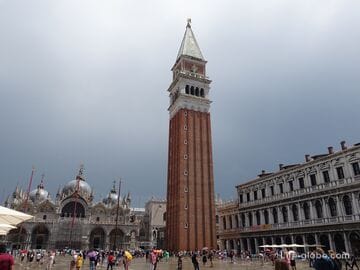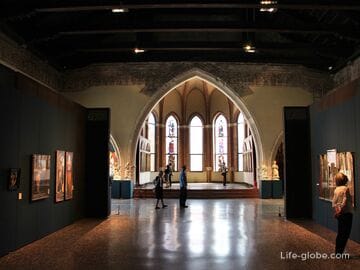The Doge's Palace or Ducal Palace (Palazzo Ducale, Venetian name: Pałaso Dogal) is the former residence of the Doge (the oldest and highest magistracy of the Republic of Venice) in Venice, which is a masterpiece of Gothic art, which now houses a museum.
The Doge's Palace is one of the main and most visited attractions of Venice today.
In the Doge's Palace, you can visit the wings of the palace with galleries, halls, executive rooms, apartments of the Doge, as well as the prison, armory and secret routes.
In the premises of the palace there are collections of antiquities, as well as temporary exhibitions.
The Doge's Palace is located in the heart of the historical part of Venice, on St. Mark's Square (Piazza San Marco) and Slavyanskaya Embankment (Riva degli Schiavoni, Riva degli Schiavoni). The palace is adjacent to the Cathedral of St. Mark (Basilica of San Marco, Basilica di San Marco).

The first Doge's palace was built in the 9th century, but later it was partially destroyed by fire and rebuilt by Doge Sebastiano Ziani. Only some features of Byzantine-Venetian architecture remain from this palace, which can be seen on the ground floor.
The construction of a new large Gothic palace took place between 1309 and 1424, presumably by the architect Filippo Calendario, and was associated with political transformations, changes in the understanding of the structure of palaces and an increase in the number of members of the Grand Council.
In 1577, part of the palace was destroyed by a large fire, after the palace was restored. Subsequently, the palace was expanded; so, in the 17th century, a New prison (Prigoni Nuove) and the Bridge of Sighs (Ponte dei Sospiri) were built, which connected the prison with the Doge's palace.
As a ducal residence, the palace housed, first of all, the Doge, as well as other political institutions of the Republic of Venice, until the occupation of the city by Napoleon in 1797, when the role of the palace inevitably changed. Venice was subordinated first to French rule, then to Austrian rule, and finally, in 1866, became part of Italy. During this period, the palace housed various administrative offices, as well as a library.
By the end of the 19th century, signs of dilapidation appeared in the building, and the Italian government decided to restore the palace, and all state institutions were moved to other places. In 1923, the palace was transferred under the management of the Venetian municipality as a museum. So the Doge's Palace became a museum, which it is today.
The palace has two main facades in the Gothic-Venetian style, facing St. Mark's Square and the pier (lagoon). The facades of the palace are distinguished by airy loggias with columns, lancet windows, balconies and sculptural decorations.
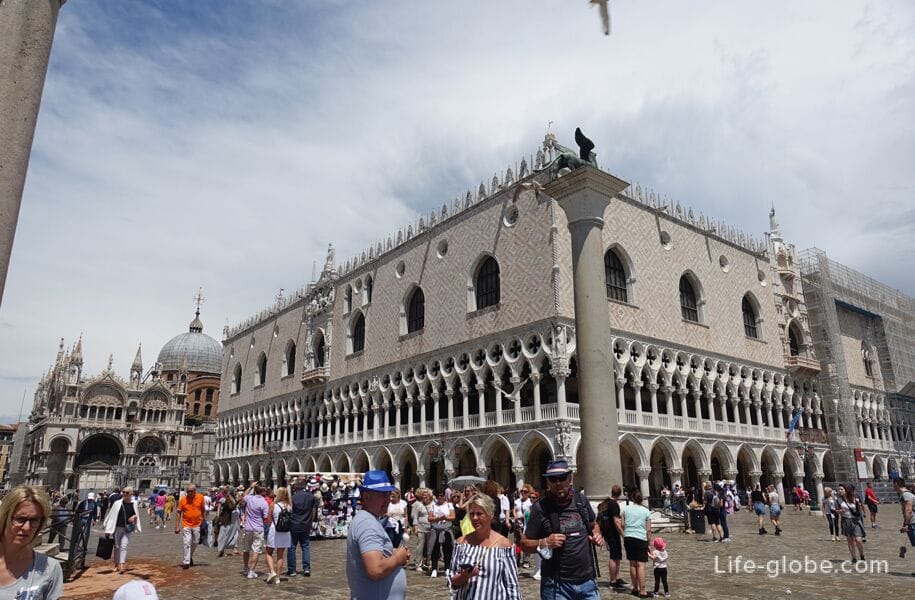
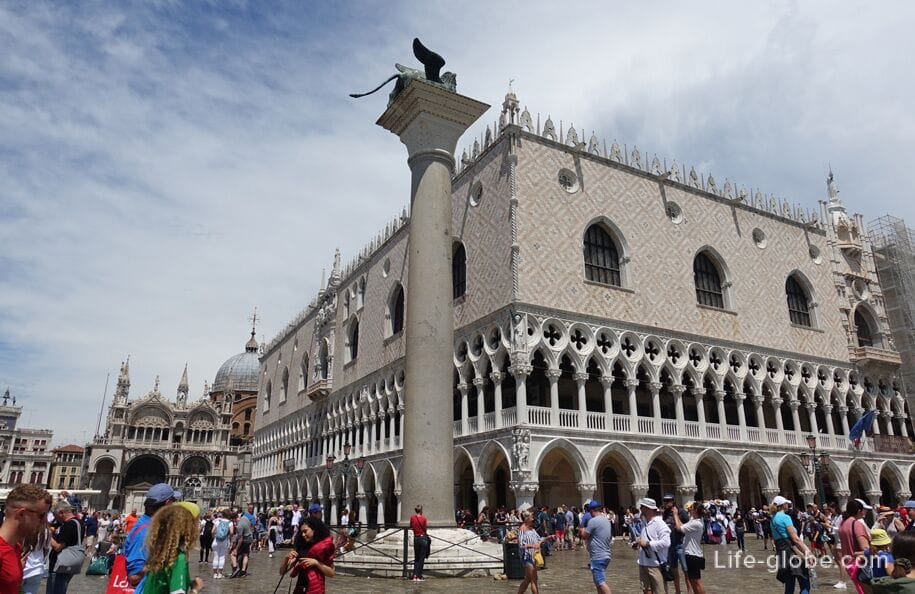
The magnificent Gothic facade of the palace, overlooking the Venetian Lagoon, is the oldest wing. The facade is decorated with sculptures from the 14th century, presumably by Filippo Calendario and various Lombard artists such as Matteo Raverti and Antonio Breno. The arcade of the first floor and the loggia above (central balcony) are decorated with capitals of the 14th and 15th centuries, some of which were replaced by copies in the 19th century.
The balcony of the "Hall of the Grand Council" (Sala del Maggior Consiglio) is the work of the brothers Jacobello and Pierpaolo dalle Masenye, between 1400 and 1404.
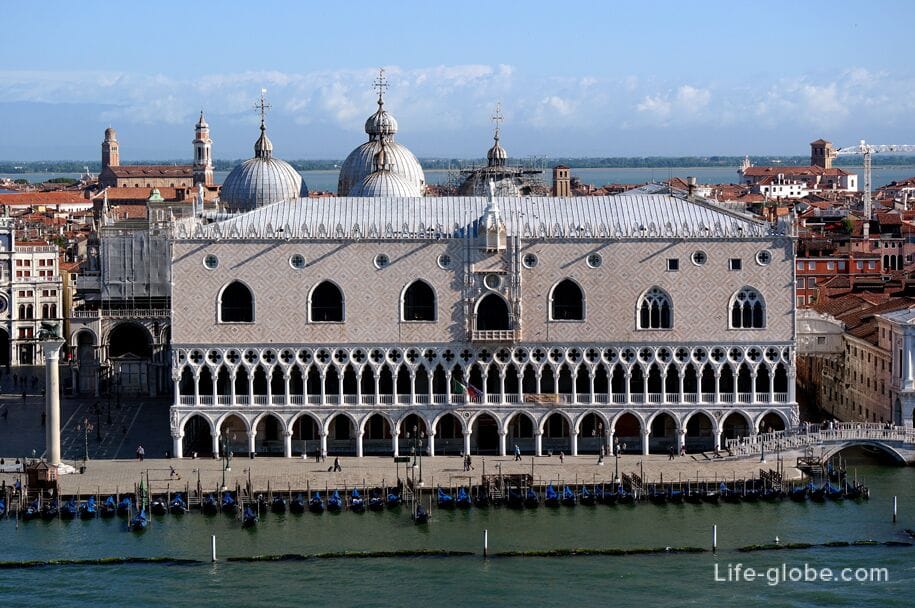
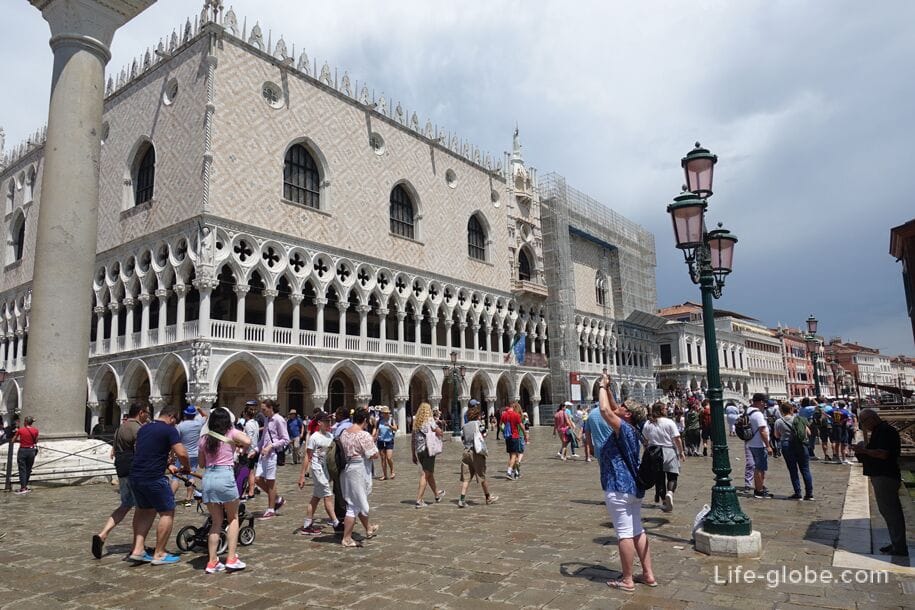

The facade facing San Marco Square was built a little later, starting in 1424. This wing, built by order of the Doge Francesco Foscari, was intended for the functions of justice.
The facade of this wing of the palace wing is similar to the first wing. It also has an arcade, loggia and sculptural decorations.
In the loggia on the ground floor, also known as the Foscara Loggia, two columns of red Verona marble can be seen: death sentences were read between them, which were then carried out between the columns of San Marco and San Teodoro, towering in the Piazza San Marco. On the thirteenth column (in the direction from the lagoon to the square) there is a sculpture "Justicia on the throne".
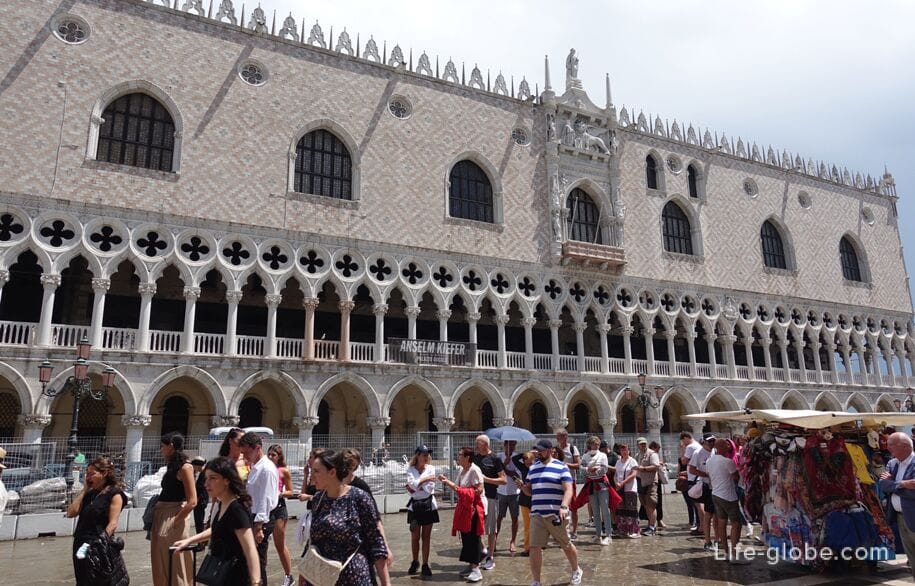
The balcony of the facade has sculptures and the winged lion of San Marco with an open book and belongs to the period between 1531 and 1538 (according to some sources, to 1536). The balcony was designed by Sansovino. On the sides of the structure there are two niches with statues of Mars and Neptune, crowned with two Glories with a torch; the upper panel, containing a copy of the sculptural group with the Doge Andrea Gritti and the lion of San Marco, destroyed during the French occupation in 1797 and remodeled in the nineteenth century, is framed by statues, one of which depicts Mercury, and the other Jupiter. A statue depicting Venice placed on top of a balcony.
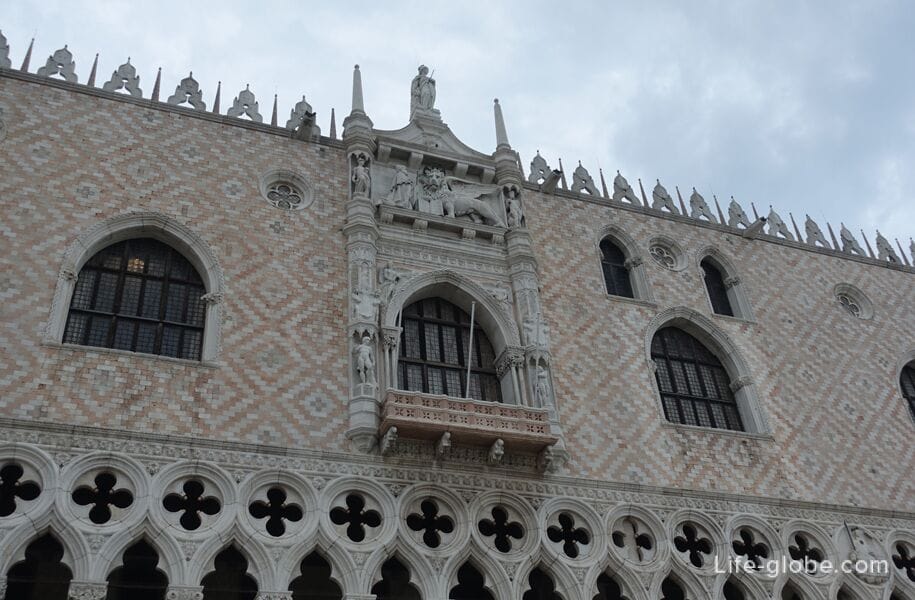
Also from the side of the square, in the place where the palace adjoins St. Mark's Cathedral, the entrance gate attracts attention (Porta della Carta, Porta della Carta - the Gate of paper, Venetian name: Porta de la Carta). The gate probably owes its name to the fact that it seems to hint at the presence here (sitting at the gate) of public clerks who accepted petitions to the Senate and drew up business papers for private individuals; or that there were archives of state documents nearby.
These are one of the two main entrances to the palace; they lead to the front courtyard of the Doge's Palace.
The gate is an outstanding monument of Venetian Gothic architecture. Above the entrance is a relief image of the lion of St. Mark, the emblem of Venice, and the kneeling figure of the 65th Venetian Doge Francesco Foscari. Above is the belt high relief of St. Mark. The gate is crowned by a statue of Justice with a sword and scales - an allegory of Justice and Justice.
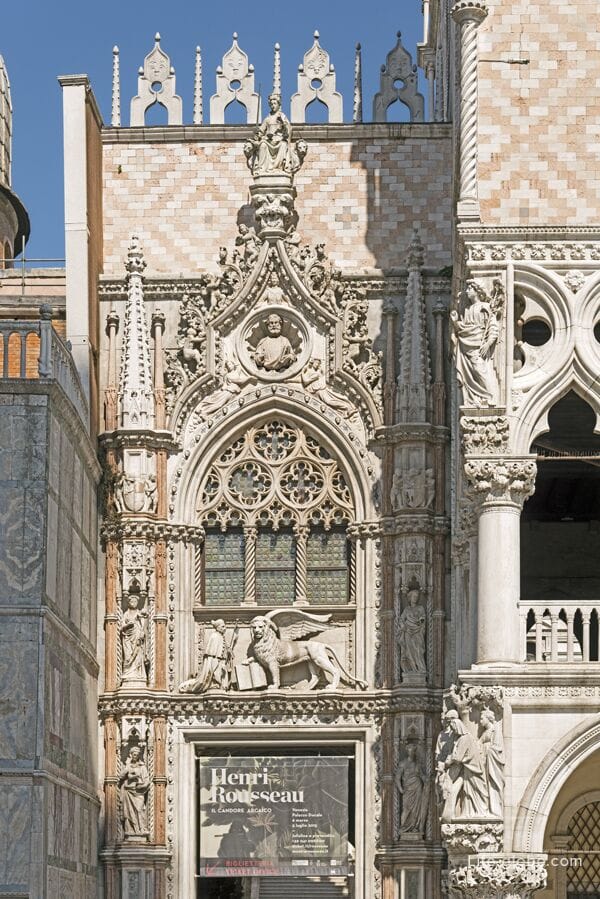
Finally, the most recent in the complex is the east wing facing the Palace Canal (Rio di Palazzo, Rio del Palazzo). This wing was built by Antonio Rizzo after a fire in 1483 in the Renaissance style. This facade is quite modest; there are statues depicting the Intoxication of Noah, and a group of Raphael and Tobiolo forming a corner; and the only sculpture entirely placed on the facade is the sculpture of the so-called Third Son of Noah.
Adjacent to this facade is the Bridge of Sighs, which connects the palace with the building of the former prison. Today, the bridge and the prison are also part of the museum of the Doge's Palace and they can be visited.
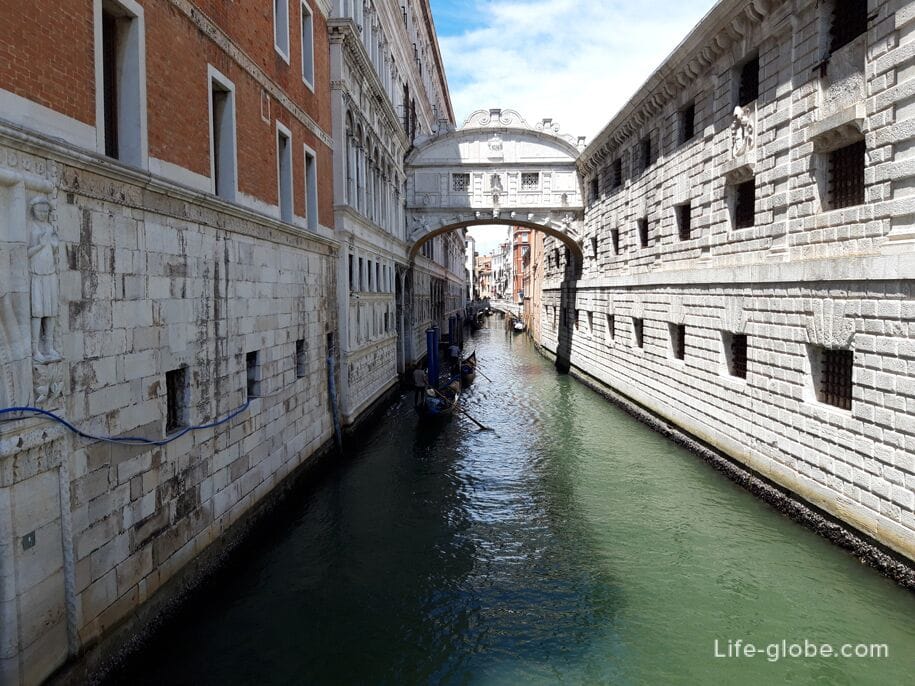
The courtyard of the Doge's Courtyard
There is an inner courtyard between the wings of the Doge's Palace.
Three sides of the courtyard are framed by the wings of the Doge's Palace, while the fourth, facing St. Mark's Cathedral, has a small marble facade with a clock, which dates back to the reconstruction of 1615.
In the center of the courtyard are two wells, massive and ornate bronze castings dating from the middle of the sixteenth century.
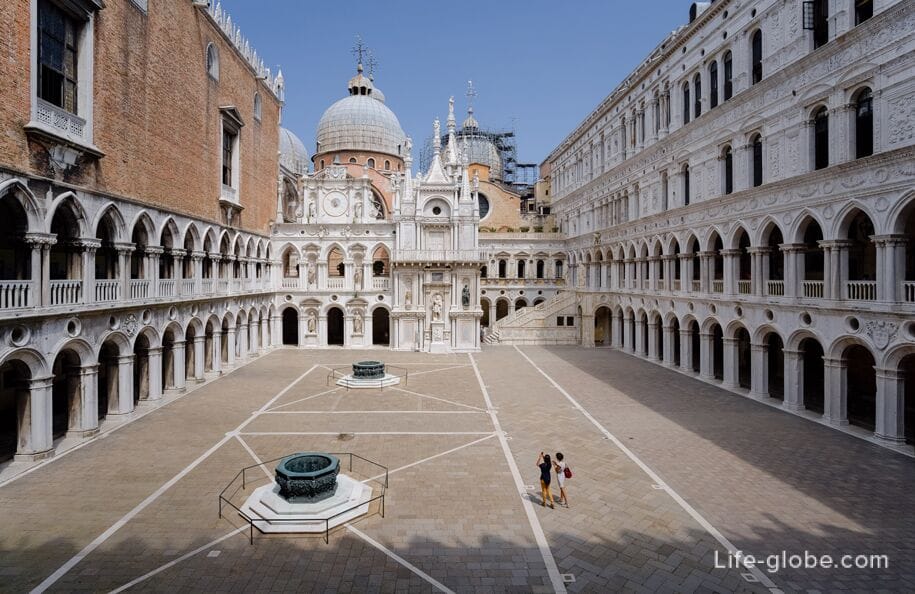

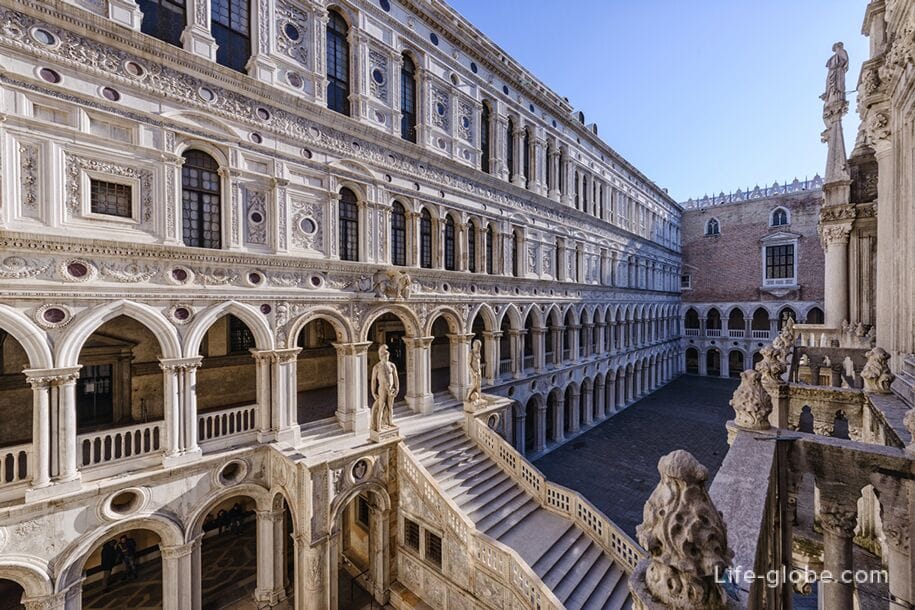
The two oldest wings of the palace have simpler and stricter facades in the courtyard, while the Renaissance wing has a richer decoration, which ends at the bottom with a staircase of Giants (Scala dei Giganti, Scala dei Giganti). It was an ancient entrance of honor, decorated with two colossal statues of Mars and Neptune (a symbol of the power of Venice on land and at sea), the work of sculpture Sansovino in 1565.
The staircase, designed by Antonio Rizzo, adjoins the arch dedicated to Doge Francesco Foscari.

Interiors of the Doge's Palace
All the interiors of the Doge's Palace can be divided into parts, which include
Loggias of the palace
In the palace museum, you can walk along the loggias of the wings of the palace, from where you can enjoy views of the square, the lagoon and the courtyard.
Master's offices were located along the wings.
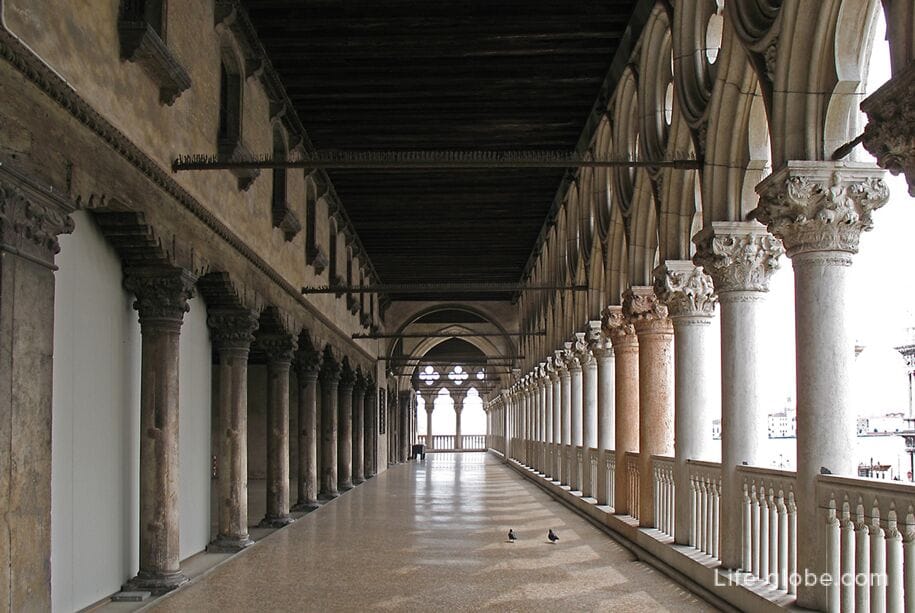
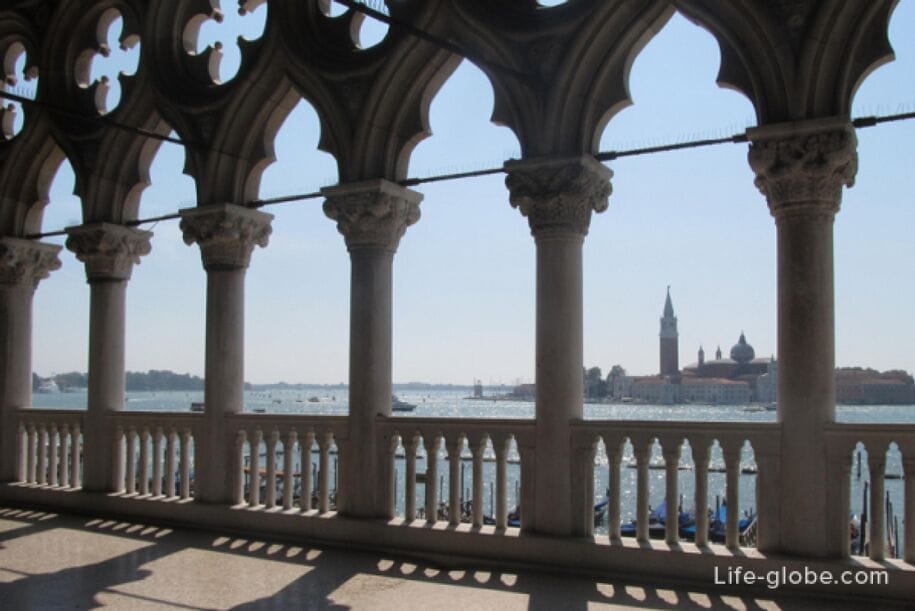
Opera Museum
The so-called Opera Museum (Il Museo dell'Opera), located on the ground floor of the palace, is a former room that in ancient times was a kind of technical office responsible for the maintenance of the building and the management of countless reforms and reconstructions that the palace has undergone throughout its long history.
In the halls there are sculptures, columns, capitals, porticos, reliefs and other parts that once decorated the facades of the Doge's palace.
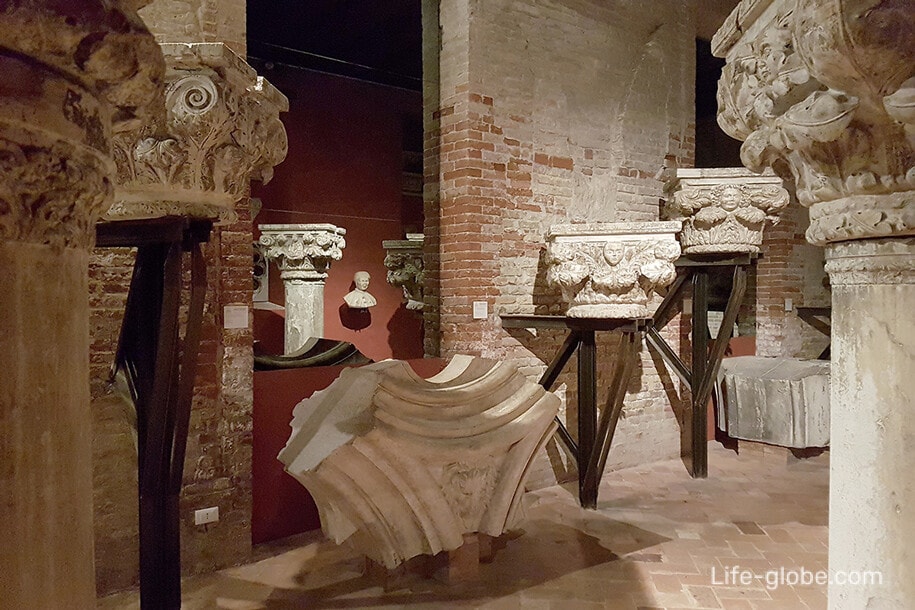
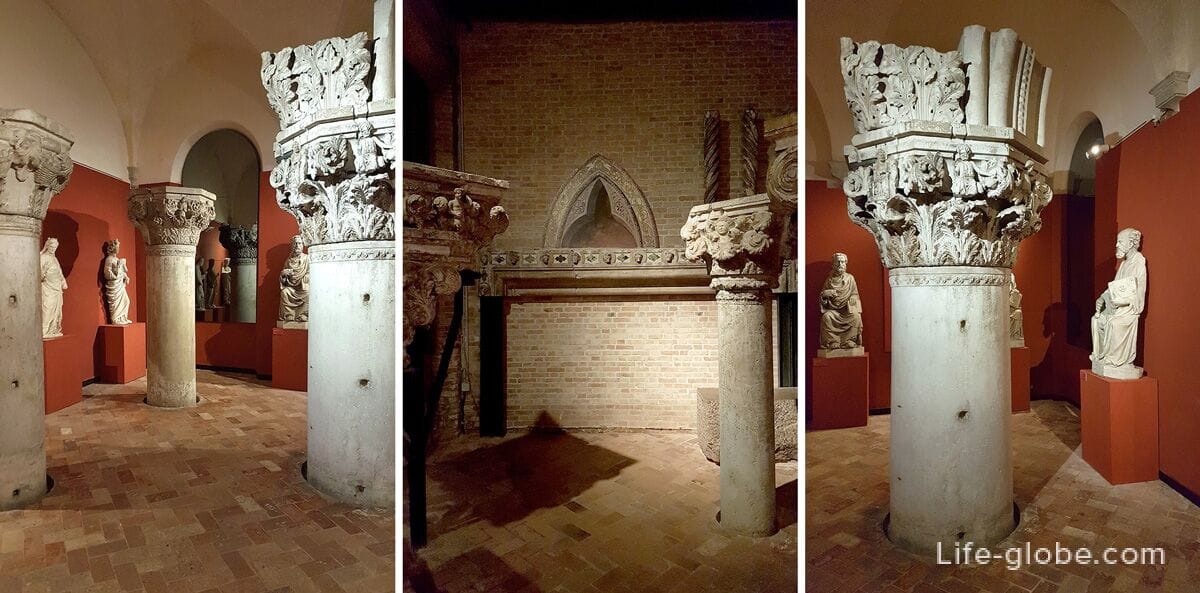
Doge 's Apartment
The so-called "Doge's Apartment" contained the Doge's private quarters, the guards' quarters and halls used for receptions and events.
The entire area was destroyed by fire in 1483, and then rebuilt in Renaissance style.
Temporary exhibitions are held in the Doge's apartment.
From the rooms:
The Scarlatti Hall (Sala degli Scarlatti) is a room that was once used as a reception room for ducal advisers.
The hall stands out: a carved ceiling, probably designed and executed by Biagio and Pietro da Faenza, which depicts the coat of arms of Andrea Gritti (doge from 1523 to 1538); a fireplace with a beautiful ornament with cornucopias, acanthus leaves, curls, putti heads, which is the work of the workshop of Antonio and Tullio Lombardo of the early 16th century. centuries; marble relief above the entrance door with Leonardo Loredan (Doge from 1501 to 1521).
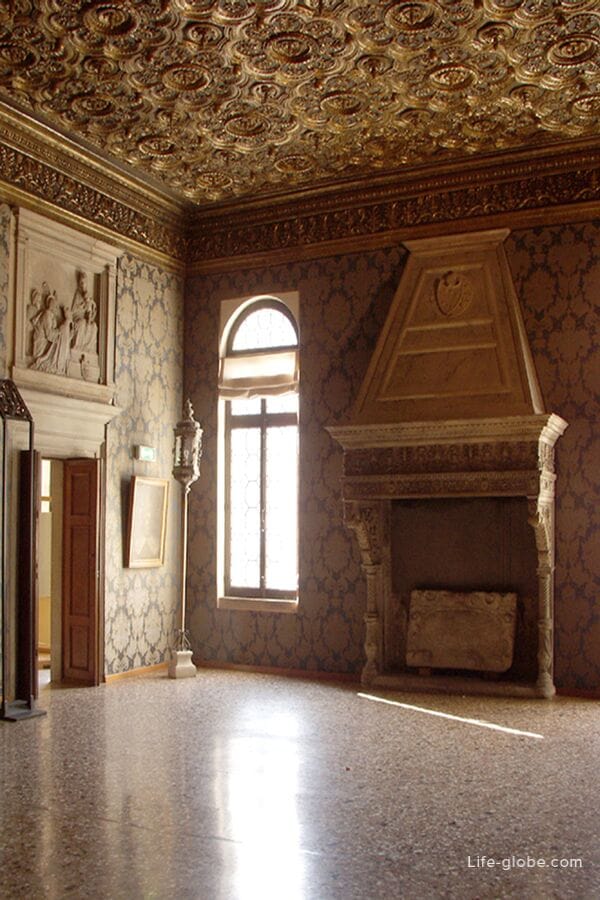
The Hall of the Shield (Sala dello Scudo), whose name comes from the custom of hanging the coat of arms (shield) of the ruling doge, who gave audiences and received guests here. The sign displayed in the hall belongs to Ludovico Manin, the last Doge of the Republic before the fall of 1797.
A large decoration with geographical maps reproduces the possessions of the Republic or remote regions explored by the Venetians. The original version of the maps laid out along the two main walls dates back to the sixteenth century. Then they were remade in 1762 by cartographer and polygraphist Francesco Grisellini, who, by order of the writer-Doge Marco Foscarini, added other paintings describing the travels of the most famous Venetian explorers: Nicolo and Antonio Zen, exploring the new world (Greenland); Pietro Cerini, shipwrecked in the Norwegian fjords; Alvise da Mosto, discoverer of the islands of the Green Cape.
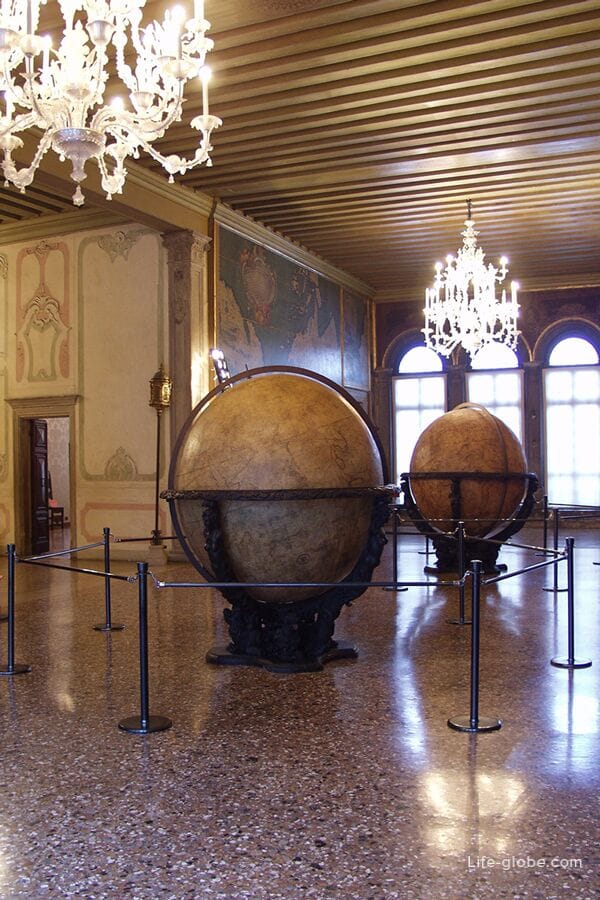
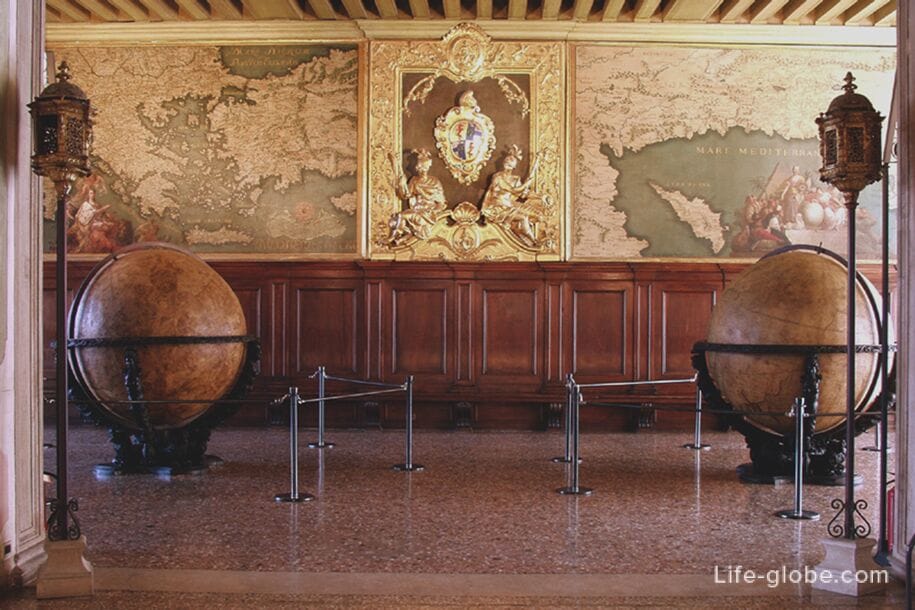
The Grimani room (Sala Grimani), whose carved ceiling dates back to the Doge of Barbarigo (1485-1501), but the coat of arms applied in the center dates back to the end of the sixteenth century and belongs to Grimani, from whom the room got its name.
Notable in the hall is also a fireplace belonging to Lombardo's workshop, decorated with the coat of arms of Barbarigo and distinguished by an elegant decorative ribbon with a Martian lion surrounded by deities and sea figures, and the stucco above the tassel dates back to Doge Pasquale Cicogna (1585-1595). The frieze under the ceiling, made at the end of the 16th century, during the time of the Doge Marino Grimani, represents allegorical figures, various personifications, including Venice and the evangelist Mark with a lion.
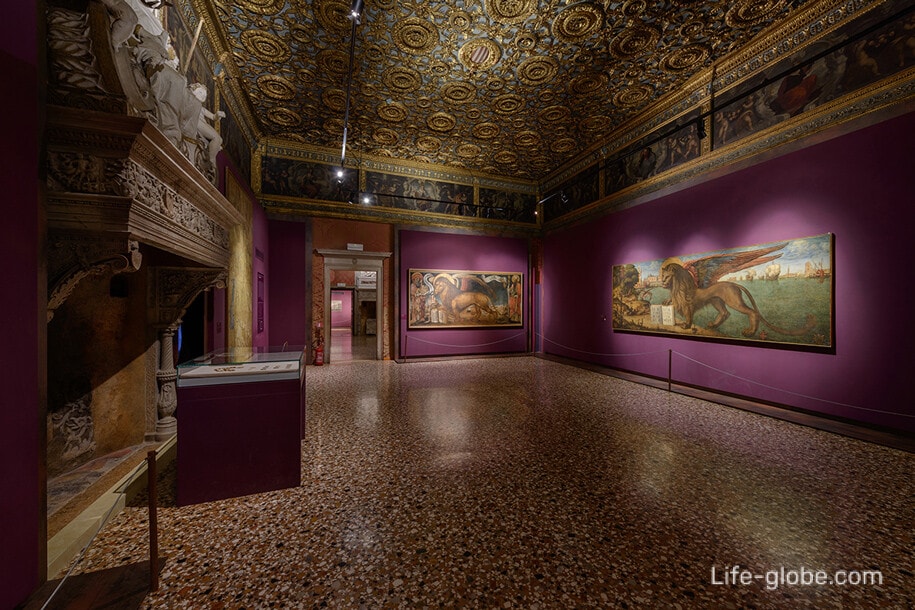
The Room of Erizzo (Sala Erizzo), owes its name to Francesco Erizzo, Doge from 1631 to 1646.
The ceiling with gilded carvings on a blue background and the Lombard fireplace date back to the end of the fifteenth century. The coat of arms of Erizzo between Venus and Volcano, crowning the hood, appeared later. Along the walls there is a frieze with cherubs and military symbols, which seems to hint at the exploits of Doge Erizzo, who reached the top of the state, primarily due to his military merits.

The Stucco room (Sala degli Stucchi), in which the stucco of the cylindrical vault marked with lunettes dates back to Doge Marino Grimani (1595-1605), and the coat of arms adorning the fireplace, crowned with allegorical figures, belongs to Doge Antonio Priuli (Doge 1617-1623). Another Grimani, Pietro (Doge 1741-1752), commissioned stucco decorations on the walls, and also created frames for paintings exhibited here since then, illustrating various Episodes from the life of Christ and a Portrait of King Henry III of France (possibly painted by Jacopo Tintoretto), to whom Venice gave an impressive reception in 1574, when he He was on his way from Poland to France to inherit the throne left by his brother Charles IX.

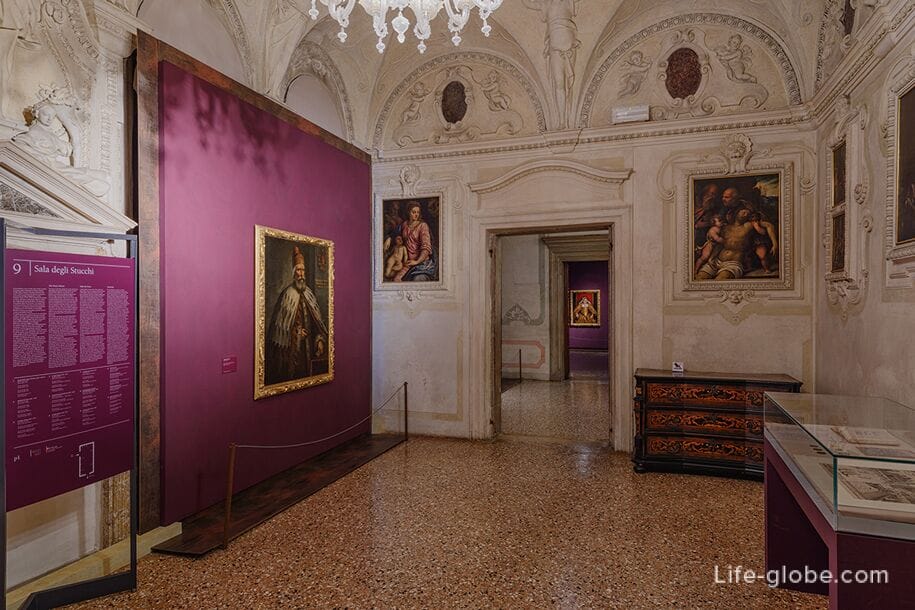
The Hall of Philosophers (Sala dei Filosofi), which got its name from the twelve images of ancient philosophers that were placed in the hall in the eighteenth century, and then replaced by allegories and portraits of doges.
In the left wall there is a small door leading to an internal staircase, by which the doge could quickly get from his apartments to the rooms on the upper floor where the Senate and the Collegium met.

The Hall of Shelters (Sala delle Volte) is a room probably used for private events, which is one of the few in which there is no fireplace or other original decorations.

Audience Hall (Sala dell'udienza). The room may have been identified as one of three reserved for guests in this part of the palace.
The room has a notable Carrara marble fireplace with carved winged cherubs on dolphins and the lion of St. Mark in the center, as well as a carved wooden frieze under the ceiling, both dating from the end of the fifteenth century.
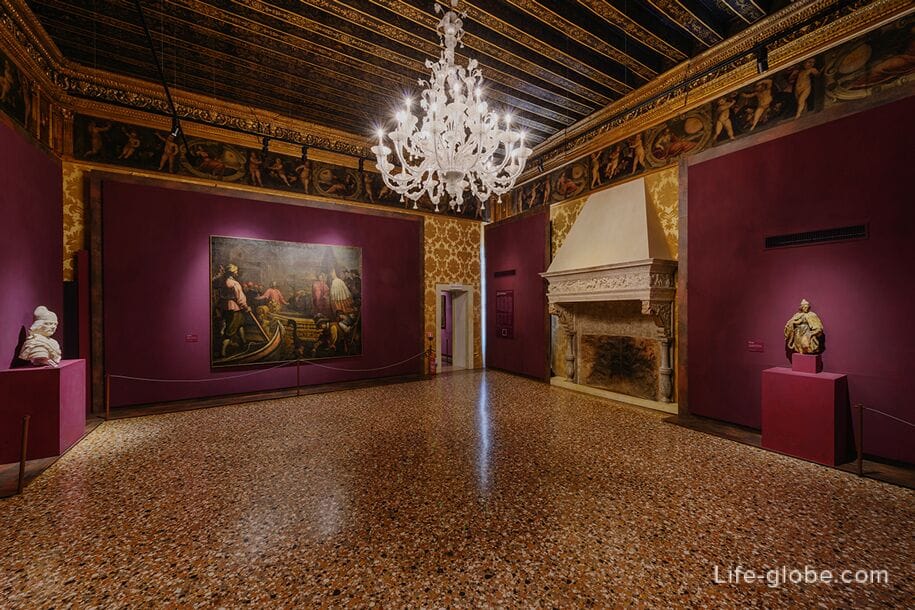
The Hall of Antiaudienza (Sala dell'antiudienza). The special function of this room is also not defined, and it has certainly changed its purpose many times. The fireplace has been preserved from the original furniture;
The Hall of Squires (Sala degli Scudieri). Originally it was a room from which one could get to the Doge's apartment. It housed his squires, appointed for life directly by the doge, eight of whom were always to be at his disposal. There is no original decoration in the room, and its greatest value is represented by two monumental portals (the end of the fifteenth century), which lead to the Scudo Hall and the Scala d'Oro.
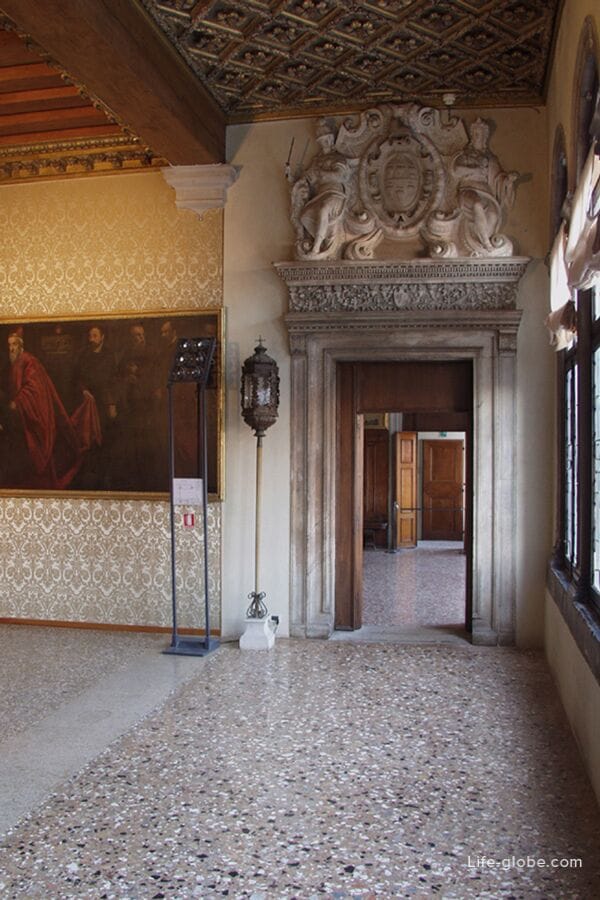
Institutional rooms
A number of other rooms and halls are called "Institutional Rooms", since the political and administrative life of the republic at the highest levels took place in them.
The halls of the most important bodies were located here: the Grand Council, the Senate, the Collegium, the Magistrates of Justice, the Council of Ten and others.
These rooms are located on several floors of the Doge's Palace.
The most attractive room is the Great Hall (Maggior Consiglio) - the largest and most impressive of the halls of the Doge's Palace. It is 53 meters long and 25 meters wide, making it one of the largest in Europe. Meetings of the most important magistracy of the Venetian state were held here.
The first stages of the doge's election were also held in this room, which continued in the adjacent Scrutinio hall.
The great Hall is decorated with paintings reminiscent of individual exploits or military episodes that took place throughout the history of Venice. Immediately under the ceiling there is a frieze with portraits of the first seventy-six doges of Venetian history (the rest are in the Scrutinio hall). These are imaginary images, since those created before 1577 were destroyed by fire. Along the entire wall, behind the throne, there is the world's largest canvas "Paradise", created by Jacopo Tintoretto and his workshop between 1588 and 1592 on the site of the Guariento fresco, which was destroyed by fire in December 1577.

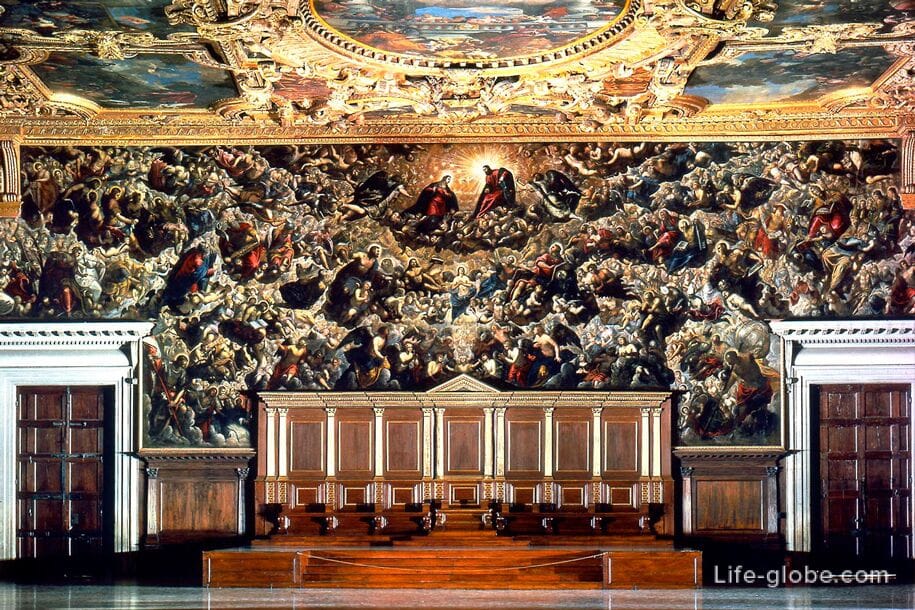
The Hall of Scrutino (Sala dello Scrutinio) is a huge hall, which was originally intended for storing precious manuscripts left by Petrarch and Vissarion to the Republic (1468). In ancient times, this room was called a Library. Then, in 1532, it was also decided to hold ballots here, that is, electoral and/or advisory operations for counting the votes of assemblies that had their epicenter in the nearby hall of the Grand Council. After the construction of the Sansovine Library (the Marcian Library), this room was intended exclusively for electoral operations, starting with the most important, the Doge.
The hall has a rich ceiling decoration designed by cartographer Cristoforo Sorte. The ceiling drawings reproduce episodes of military history extolling the deeds of the Venetians, with special emphasis on the conquest of the maritime empire: the only exception is the last oval, reminiscent of the capture of Padua in 1405. The paintings on the walls of the hall tell about the battles won from 809 to 1656. On the frieze under the ceiling, a series of portraits of the doges continues, which began in the adjacent hall of the main council, and the south wall is decorated with the "Last Judgment" by Jacopo Palma il Giovane, painted between 1594 and 1595. The hall is closed from the north by the majestic triumphal arch (the work of Andrea Tirali), which was erected in honor of Doge Francesco Morosini of the Peloponnese, who died in 1694 during the war in the Morea.
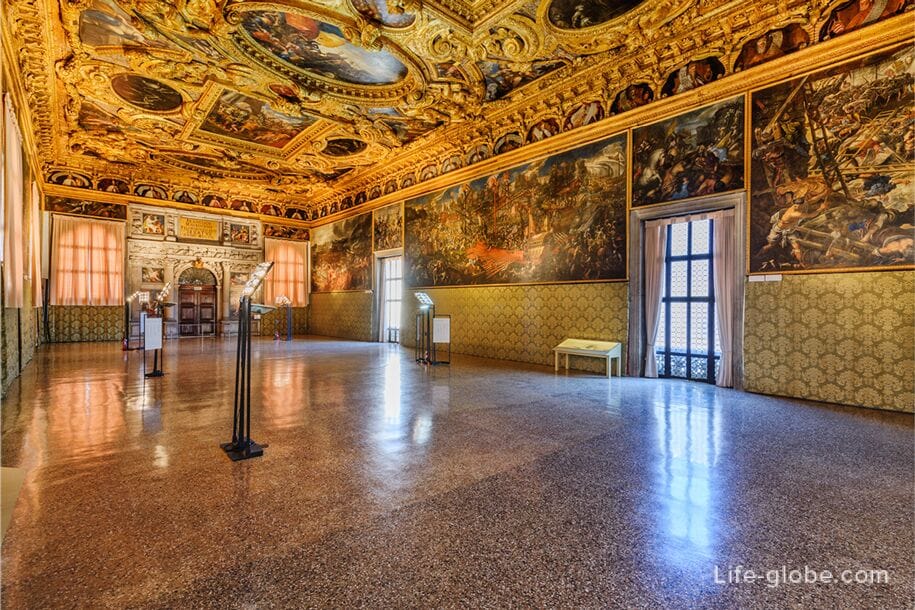

Other halls: Liago - a room for meetings and walks; atrium; rooms dedicated to the administration of justice; magistrate halls; hall for embassies and delegations; halls of the collegium and Senate; hall of the Council of Ten; hall for the protection and checks of the aristocracy; hall of the military police; a room that was a weapons depot.
In the rooms you can see some furniture, exquisite decoration, frescoes, sculptures, paintings, stucco molding and other decorations.
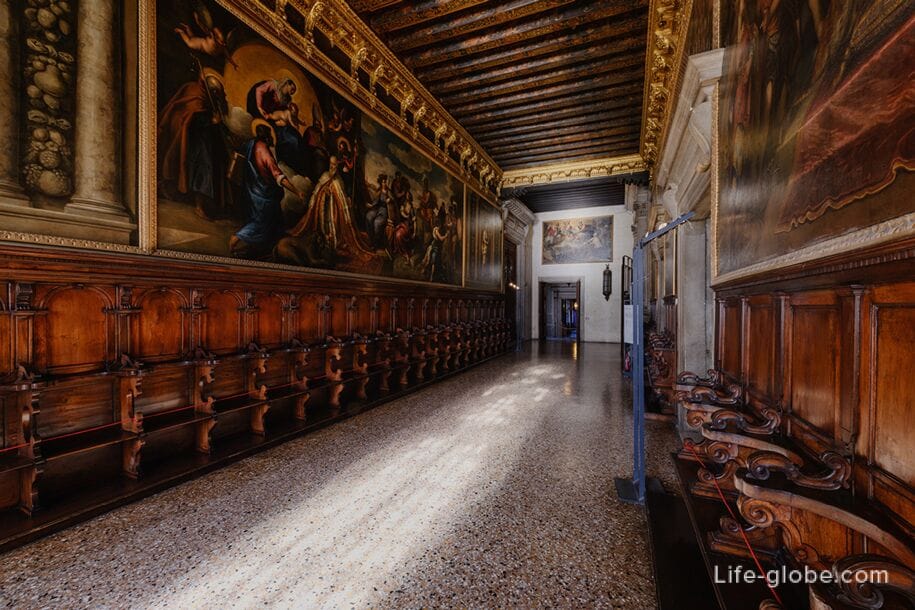

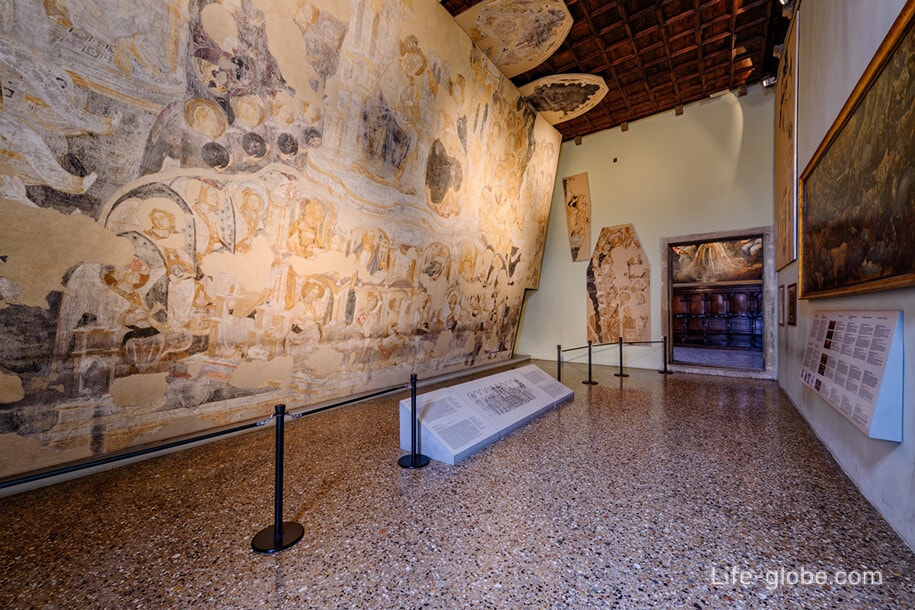
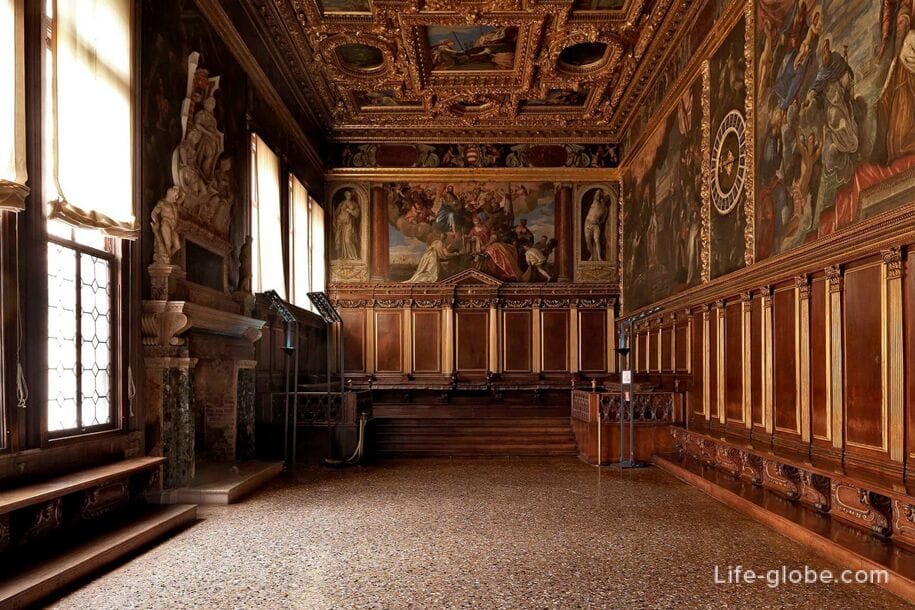
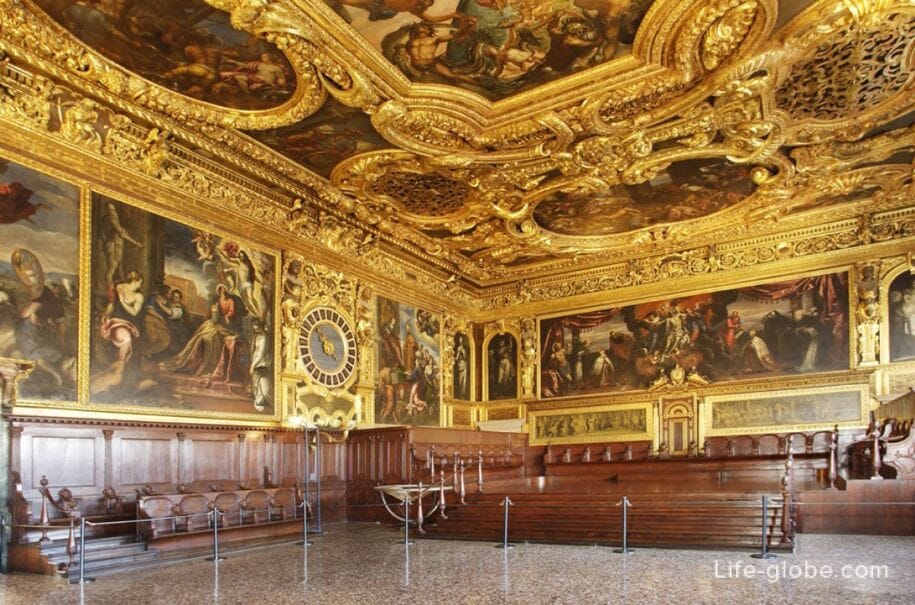
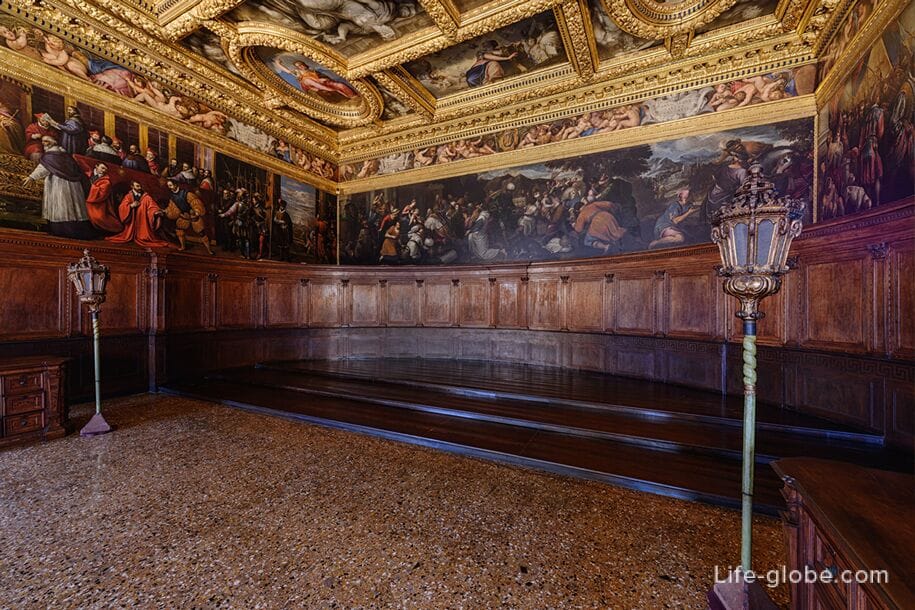
Prisons and the Bridge of Sighs
The Doge's Palace, which housed all government institutions of the republic, including the judicial authorities, also housed places of punishment and detention. But starting from the second half of the sixteenth century, it was decided to build a new prison building.
So, at the beginning of the 17th century, the building of a New prison (Prigoni Nuove) was erected, which was located on the other side of the Palace Canal from the Doge's Palace. To connect the two buildings, a bridge was built, later called the "Bridge of Sighs" (Ponte dei Sospiri, Ponte dei Sospiri), which was (and is) a covered hinged and had internal corridors along which convicts were taken from the premises of justice, where the verdict was pronounced, to prison cells to serve their time. The prisoners, passing over the bridge and seeing "freedom" through the small windows of the bridge, sighed, which is why the bridge got its name.
In 1755, the famous Italian adventurer, traveler and writer Casanova, who escaped from prison in 1756, from which there had never been a single escape, was sentenced to serve time in the Doge's Palace prison.
From the outside, the bridge can be seen from the Straw Bridge (Ponte della Pagliasco) on the Slavyanskaya Embankment (Riva degli Schiavoni, Riva degli Schiavoni). More about the Bridge of Sighs...
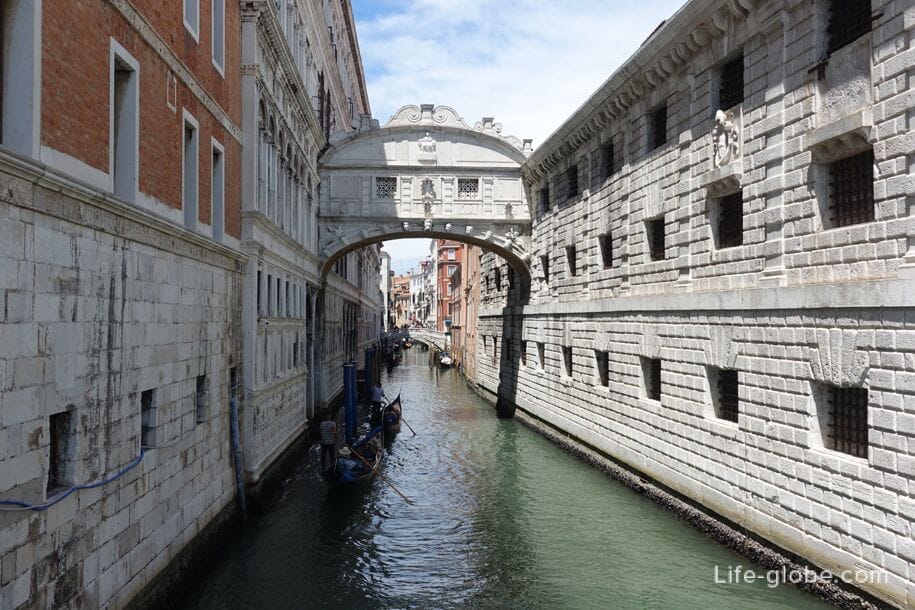
You can walk inside on the bridge and visit the former New prison with a courtyard when visiting the Doge's Palace. Several chambers house a collection of ceramics from various archaeological excavations in this area of Venice.
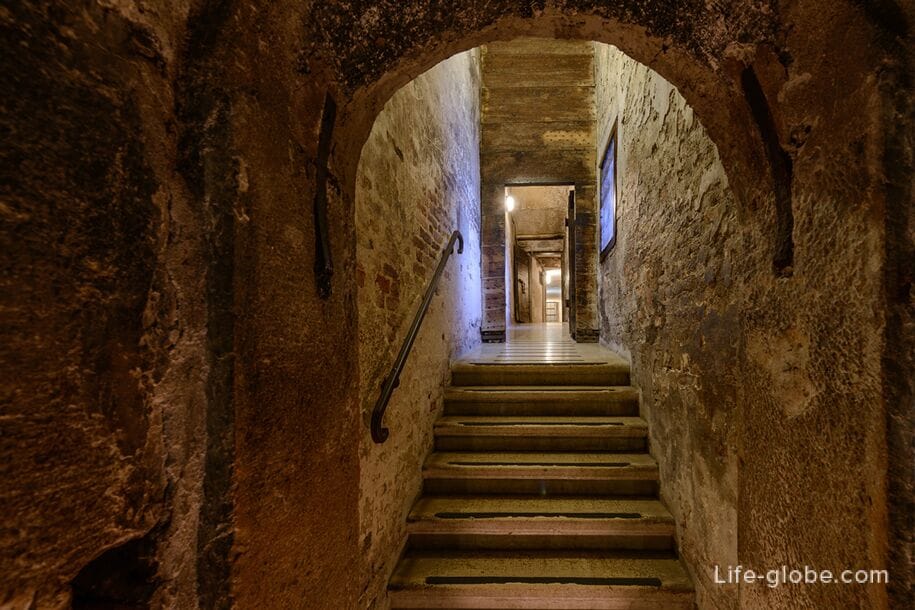


The construction of a new prison connected to the palace, followed by the construction of the Bridge of Sighs, aimed to improve the living conditions of prisoners with the help of larger, lighted and ventilated cells. Each cell was traditionally lined with crossed larch boards and densely nailed along the walls, on the floor and on the vault. The new prison represents, for the time when it was built, one of the first examples, if not the first in Europe, of an isolated, single purpose building that was destined to become a state prison.
Armory Chamber
The halls of the Armory today are a museum of weapons and ammunition of various origins, the core of which has been documented since the fourteenth century and during the Republic was transferred to the care of the Council of Ten and is characterized by military attributes, easily used by the squires guarding the palace, and, in the most delicate situations, arsenalotti, that is, qualified and organized employees of a large Arsenal complex.
Also in the halls of the museum are exhibited:
- armor, including the armor of Henry IV of France, which he presented to the Republic in 1604;
- fifteenth-century armor for a horse's head, several large broadswords and two ornate fire halberds;
- miscellaneous weapons of the 16th-17th centuries;
- instruments of torture, chastity belt and a number of weapons prohibited due to their small size, which made them easy to hide, originally belonging to the Carrara family from Padua, conquered by the Venetians in 1405;
- the devil's box is an insidious death trap that hides four barrels shooting into its hole and a poisoned arrow;
- A Turkish relic is a triangular banner won during the famous Battle of Lepanto in 1571, decorated with a border on which verses from the Koran are embroidered, it has an inscription in the center paying homage to Allah and his prophet Muhammad.


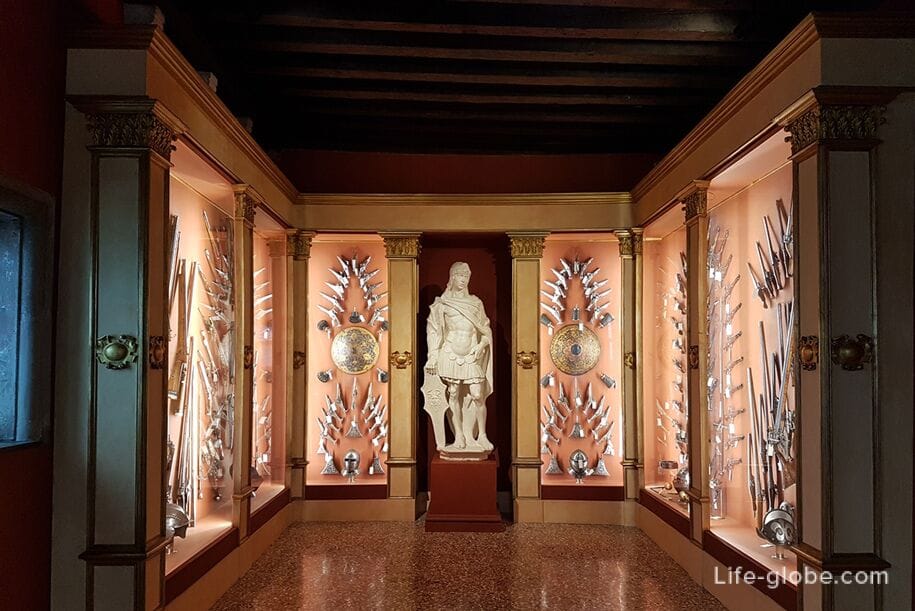
Secret routes of the Doge's Palace
In addition to the main ones listed above, there are "Secret Routes" through the Doge's palace.
Secret routes run through some of the rooms in which delicate and important actions related to the administration of the state and the exercise of power took place in the centuries of His Serene Highness. So, here you can visit the small gray cells of the prisoners of the Doge's Palace, as well as the halls of the chancery and secret chancery, the torture room, the secret passage in the closet, the attic and the hall of inquisitors - the most terrible magistracy, created in 1539 to protect the confidentiality of state operations (its exact term is "inquisitors for the disclosure of state secrets"), which consisted of three members, two of whom were chosen from the Council of Ten and one from the Doge's advisers. They had to guarantee objectivity, competence and efficiency in their actions, as well as complete secrecy of their activities and the facts that they became aware of. They could, at their discretion, obtain information by any means, including denunciations and torture. The ceiling of the room is decorated with Tintoretto paintings painted between 1566 and 1567.
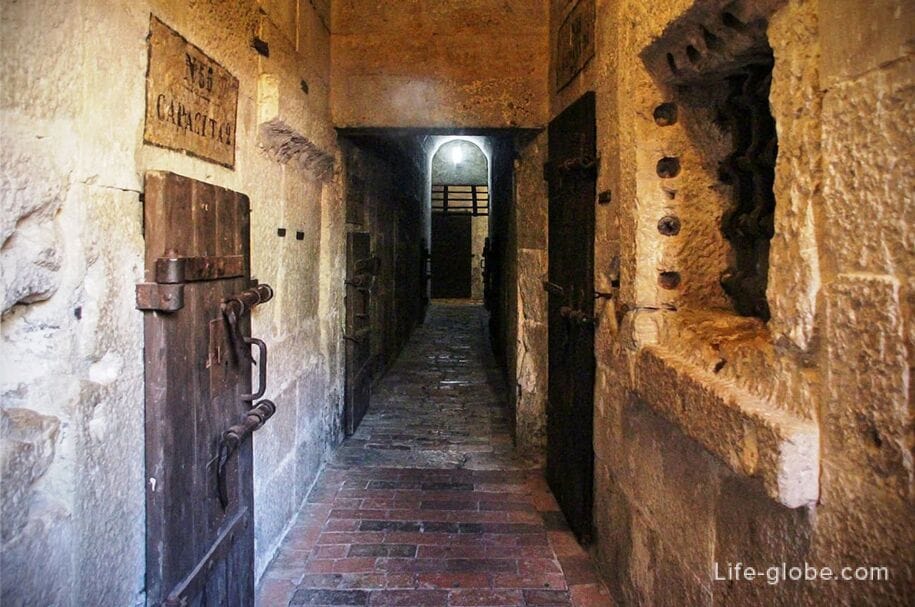

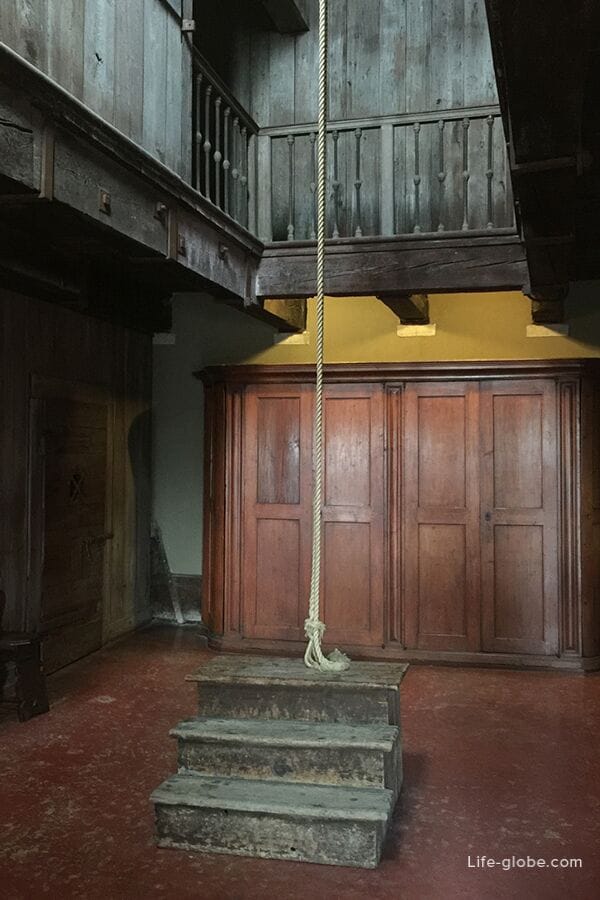
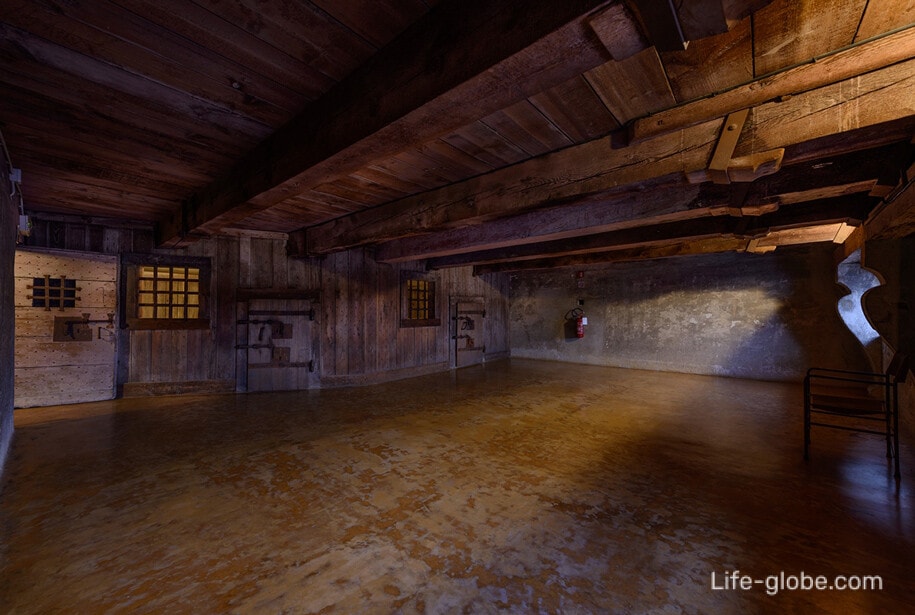
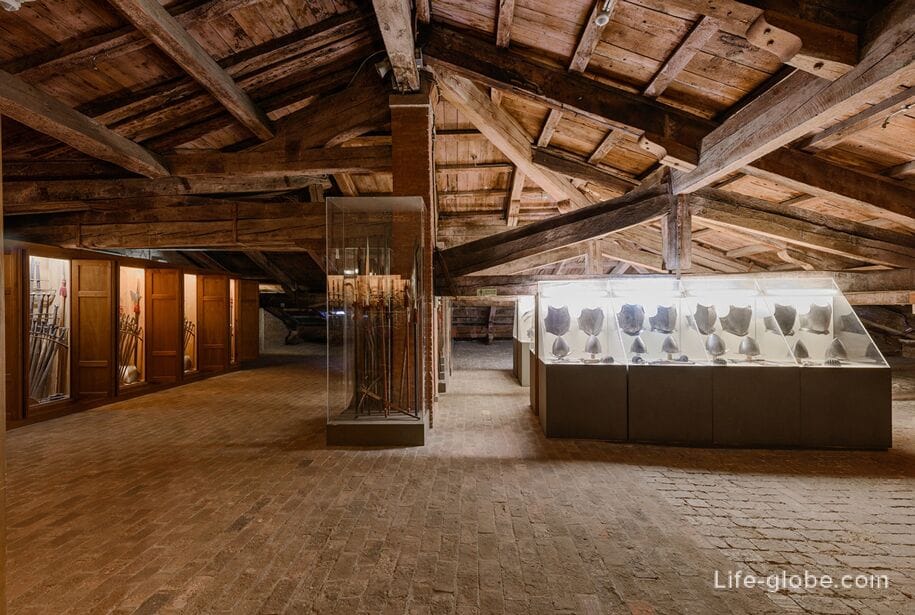
Another secret route, called "The Hidden Treasures of the Doges", during which you can visit the Loggiato, from where the highest authority of Serenissima watched the public celebrations; private apartments of the doges and their families; a small church where the doges prayed, etc.


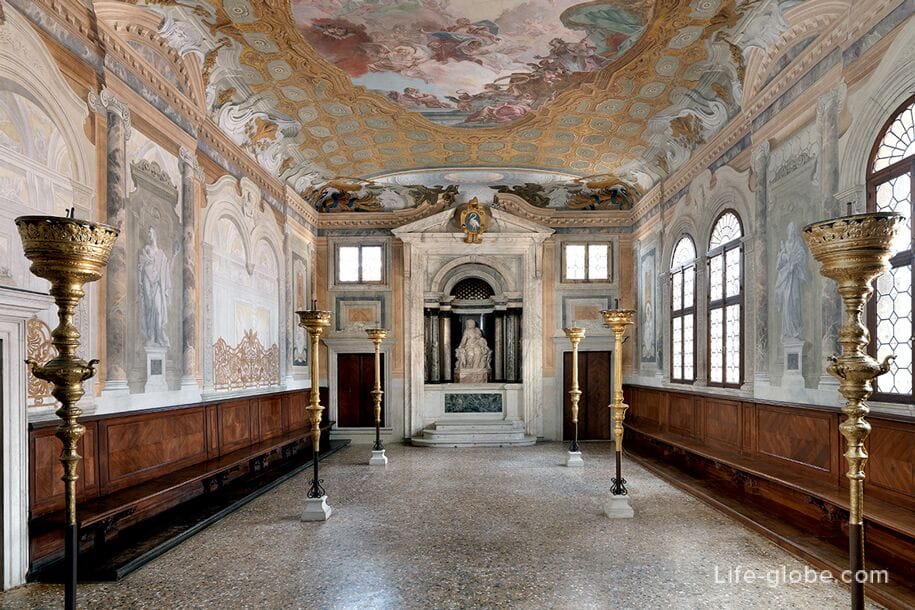

Practical information
Entrance to the Doge's Palace is paid. There are discounted tickets. Children under 6 years old - free of charge.
An audio guide is available for a fee.
A ticket to visit the Doge's Palace is included in a comprehensive ticket to visit other museums on St. Mark's Square: the Museo Correr, the National Archaeological Museum (Museo Archeologico Nazionale) and the monumental halls of the National Library of Marciana (Biblioteca Nazionale Marciana). The ticket is valid for 3 months and allows one entrance to the Doge's Palace and one entrance to the integrated route of the other three objects.
Visits to the Secret Routes of the Doge's Palace are paid, and are not included in the general tickets for the palace. Visiting these routes is possible when booking and with guides.
There are complex tickets for 6 months, with visits to the Doge's Palace and other public museums of Venice.
Tickets can be purchased at the box office or online in advance on the website.
Up-to-date information about the Doge's Palace, including possible halls and rooms of the palace, secret routes, cost, validity period and places of purchase of tickets, conditions of visits, opening hours of the museum, etc., we recommend checking on the official website of the Doge's Palace Museum: palazzoducale.visitmuve.it.
Address of the Doge's Palace: P.za San Marco, 1, 30124 Venezia VE, Italy.
Coordinates of the Doge's Palace: 45°26'01.0"N 12°20'25.0"E (45.433611, 12.340278).
All accommodation facilities in Venice, including in the historic city center and near St. Mark's Square, can be viewed and booked here






